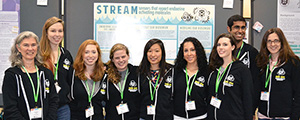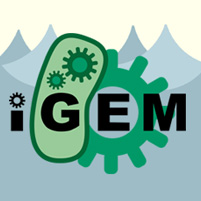Genetic Success

2014 CMU iGEM Team

As anyone with a big box of Legos knows, the possibilities as to what you can make are endless.
Each year, students who participate in the International Genetically Engineered Machine (iGEM) competition — the premier undergraduate synthetic biology contest — are presented with a similar challenge.
Each team starts with the same kit of interchangeable biological building blocks called BioBricks. What they do with them is limited only by the student's imagination. Each block has its own distinct properties, and each team can link the blocks together in a multitude of different ways using the rules of synthetic biology. The resulting creations can be dramatically different.
"I found the idea of programmable biology to be very intriguing. The use of BioBricks to build biological systems appealed to my childhood fascination with Legos," said team member and biological sciences major Danielle Peters (CMU'15). "Synthetic biology lends itself to cross-disciplinary interactions, which I found to be very exciting."
Projects in this year's competition ranged from a sensor that can tell when olive oil has gone bad to a self-destructing drone. The Carnegie Mellon University team tackled a problem in environmental science by creating a sensor for detecting estrogenic activity in water.
Estradiol, a form of estrogen that is used to treat osteoporosis, symptoms of menopause and even some cancers, is a known endocrine disruptor. These drugs and estrogenic compounds from other sources often find their way into the water system and drinking water, where they can alter development of wildlife and damage ecosystems.
CMU's team met the competition's challenge, becoming the most decorated U.S. undergraduate team at the 2014 iGEM Giant Jamboree held in Boston. There were 245 teams from 32 countries competing, and the CMU team won the Best Undergraduate Poster Award, a Gold Medal for Achievement and an Interlab Study Award.
The team members came from schools across the university, making for a unique interdisciplinary collaboration.
"In the course of the project the students learned how to bring together their diverse strengths to achieve their goals," said Cheryl Telmer, a research biologist in the Mellon College of Science and one of the team's advisers. "Our business major had an incredible way of synthesizing information, our industrial design student was excellent at visually communicating information, and the biologists and engineers were great at translating the technical information within the team and to the community."
Team members included: Peters, biological sciences and business major Ali Celentano (TPR'15), biomedical engineering and materials science & engineering major Dominique MacCalla (E'16), civil and environmental engineering major Nicole Matamala (E'17), biological sciences and biomedical engineering major Lena Wang (S'15), industrial design major Courtney Pozzi (A'17), and electrical and computer engineering major Niteesh Sundaram (E'15).
The parts and devices made by the teams in the competition are included in the library of parts, along with instructions, to be used by future iGEM teams.
In addition to Telmer, the team was advised by: Biological Sciences and Chemistry Professor Marcel Bruchez, Adjunct Professor of Electrical and Computer Engineering Natasa Miskov-Zivanov and Professor of Electrical and Computer Engineering Diana Marculescu. They received support from a number of faculty members and funding from a number of university sources including the College of Engineering, Mellon College of Science and Tepper School of Business.
Related Links: STREAM, Sensors That Report Endocrine Activating Molecules | Mellon College of Science | College of Engineering | Tepper School of Business
